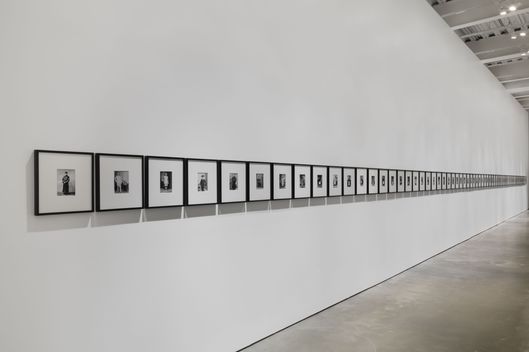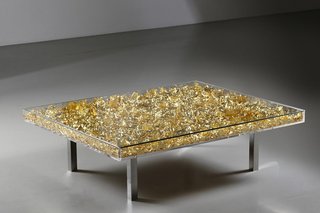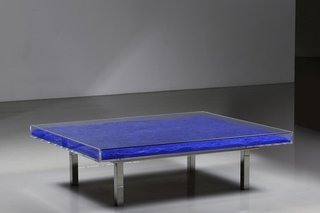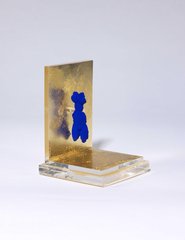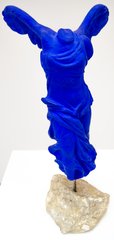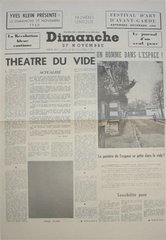Right now at the New Museum is a show that casts a much wider net, that gives weirder and more idiosyncratic work much more air to breathe — and which makes everything we’re used to seeing in museums (and even galleries) seem hemmed-in by comparison. Organized by a superb team overseen by Massimiliano Gioni, "The Keeper" is a museum full of museums, possible encyclopedias, indexes of other orders, and miniature models of pain. Most of the work takes the form of collection: virtual coral-reef phantasmagorias collected and collated from things as strange as dead languages, detritus, cats' cradles, agate, and snowflakes aren't included in the current category of art. Often, we call the people who make collections like these outsider artists — when we call them artists at all. Many of the 30 makers in "The Keeper" didn't self-identify as artists or call what they made art; their work isn't grounded in art history; probably they didn't care about this history and plumbed other axioms. A few of them are found in art museums. But most are relegated to specialty collections, foundations, barred, or forgotten.
This is because our art history is not chronological; not neutral or about simultaneous cross-styles, outliers, and other things going on at any given moment. Our art history is organized teleologically — it's an arrow. Things are always said to be going forward, and progress is measured mainly in formal ways by changes in ideas of space, color, composition, subject matter, and the like. Artists and isms follow one another in a Biblical begatting based on progress toward a goal or a higher stage. Cubism was "a race to flatness"; Suprematism was "the zero point of painting"; Rodchenko said he made "the last painting"; Ad Reinhardt one-upped him saying he was "making the last painting which anyone can make." In this system synthetic shifts and tics combine into things we call movements like Cubism, Constructivism, Futurism, Art Nouveau, Color Field, etc. The problem is anyone who doesn't fall into this timeline is out of luck. This paradigm has been in place for 200 years.
I love the art in our museums and galleries. I don't want museums to
stop staging exhibitions of it. I don't want them to look like science
fairs, flea-markets, Exploratoriums, laboratories, wunderkabinetts,
or thrift stores. But our idea of art history is dead already; it just
doesn't know it. Its terms are so specialized and vague they're only
useful to those in the know. Post-Minimalism only tells you it came
after something called Minimalism. Only aficionados know why Barnett
Newman's monochrome paintings and Willem de Kooning's wild style are
both Abstract Expressionist; why the Über-controlled David
Salle is a Neo-Expressionist. Unfortunately, so many academics,
curators, collectors, and artists are so invested in this system that we
see nonstop formalist twists, micro moves in monochrome painting,
photography about photography, readymades galore, formulaic
institutional critique, and ironies you can only understand if you read
long jargon-filled labels. This is Zombie Art History.
But there are different paradigms, different methodologies — countless numbers of them, many of them on display in "The Keeper." The artists here short-circuit art history. Not only do most of them not identify as artists, they don't see the world in any linear way. For these artists every object contains the whole world and is part of a family of forms. They look at the world in a meta way; inspiration is a compelling force from within. Not art history. In this holistic way the whole shapes the parts, taxonomical units cohere into clouds, microcosms mushroom into macrocosms, webs of interrelationship form. These artists are in search of what might be called ur-forms, conceptual templates, archetypal systems, secret chords, flows, things here for millions of centuries that are embedded in materials and in the fabric of time.
What's in "The Keeper"? Lolita author Vladimir Nabokov dissected butterfly penises — in his words, "sculpted sex" — and arranged them in cabinets to identify individual species. At the New Museum his beautifully notated Frankensteinian collages of butterfly-wing patterns show an aesthetic intelligence equal to Kurt Schwitters, Wallace Berman, and Rauschenberg. At the New Museum is Korbinian Aigner, a priest, painter, and pomologist (the study of fruit), who, starting in 1912 and proceeding while he was in Dachau to his death, in 1966, painted dusky still-lifes of apples on glowing monochrome backgrounds. His obsessional focus, power of observation, fleshy texture, and subtleness of color are as mesmerizing as Giorgio Morandi, as strange as Cézanne, as formally distinct as El Lissitzky. André Malraux, author of Museum Without Walls, said "We can only feel by comparison." Neither Aigner nor Nabokov are in our art museums to let these feelings flow. Neither is Hilma af Klint, whose 16 glorious paintings from 1914–15 cover two walls here. Her highly hued work, filled with spirals, squares, circles, and corkscrewing seashell shapes, shows that she's not just a great painter; she's one of the inventors of abstraction itself. Her plain blocky fields of color are revolutionary and don't appear in painting again until the backgrounds of Francis Bacon. Klint has received retrospectives but still isn't allotted her deserved place in art history. Maybe because she called her work "Paintings for the Temple," said she was inspired by "high masters," and designated her work not be seen until 20 years after her death. Somehow this cast her as some sort of zodiacal spiritualist.
Suffering a similar fate is Olga Fröbe-Kapteyn — who called her geometric paintings "meditation drawings" and founded a school of spiritual worship in 1930. Her 12 paintings from 1920s and 1930s at the New Museum have such snappy graphic-ness that you might mistake them for Pop or psychedelic posters of the 1960s. Nearby are 90 wild black-and-white abstract-geometric photographs by Wilson Bentley (1865–1931) who invented his own camera to made "photomicrograms" of individual snow crystals. Bentley is in a few museums. But even though this is abstract photography decades before it became an ism in art, his work is seen as scientific. At the New Museum the 500,000 pencil drawing of contemporary Vanda Vieira-Schmidt radiate an original Paul Klee–Louise Bourgeoisie synthesis. She says they are "countering the forces of evil in this world" — exactly like Byzantine and early Renaissance artists claimed. Her work can only be seen a Dresden military museum.
The funny thing is, however unusual the collections look within the context of a museum — however powerfully "The Keeper" shows us that there is more in the category of art than our present system has dreamt of — in truth I think that all great artists know this cosmic complexity already. Every maker has an individual idea of what needs to exist; great imagination is always a force from within. Whether one knows art history or not, art begins pre-intellectually, beyond language. Art is a search for new paths of encounter and poetic structures, images and things that go beyond themselves. Hilma af Klint and Fröbe-Kapteyn might have said their work was inspired by cosmic forces. Kandinsky said his art was a "penetration of collected forces." Franz Marc called it a "pantheistic penetration." Marsden Hartley called himself a "cosmic Cubist." Marcel Duchamp suspended 1,200 coal bags from a ceiling. This would fit into "The Keeper" with the string-figure cats'-cradle configurations collected by filmmaker/ethnomusicologist Harry Smith.
It's beyond time for a new generation of art historians not only to open up the system and let art be the garden that it is, home to exotic blooms of known and unknown phenomena. It's time to work against this system. We can't say painting is dead just as women and artist of color started to show up in art history. Our art history has stiffened into an ideology that clear-cuts a medium, pronounces it dead (like undertakers) and moves on like conquistadors to the next stage. The idea that art has an overall goal of advancing or perfecting its terms and techniques is made up. Imagined. Idiotic. Except to those benefiting from this intellectual fundamentalism. Someday, people will look back at this phase of art history the way we look back at manifest destiny and colonialism.
But there are different paradigms, different methodologies — countless numbers of them, many of them on display in "The Keeper." The artists here short-circuit art history. Not only do most of them not identify as artists, they don't see the world in any linear way. For these artists every object contains the whole world and is part of a family of forms. They look at the world in a meta way; inspiration is a compelling force from within. Not art history. In this holistic way the whole shapes the parts, taxonomical units cohere into clouds, microcosms mushroom into macrocosms, webs of interrelationship form. These artists are in search of what might be called ur-forms, conceptual templates, archetypal systems, secret chords, flows, things here for millions of centuries that are embedded in materials and in the fabric of time.
What's in "The Keeper"? Lolita author Vladimir Nabokov dissected butterfly penises — in his words, "sculpted sex" — and arranged them in cabinets to identify individual species. At the New Museum his beautifully notated Frankensteinian collages of butterfly-wing patterns show an aesthetic intelligence equal to Kurt Schwitters, Wallace Berman, and Rauschenberg. At the New Museum is Korbinian Aigner, a priest, painter, and pomologist (the study of fruit), who, starting in 1912 and proceeding while he was in Dachau to his death, in 1966, painted dusky still-lifes of apples on glowing monochrome backgrounds. His obsessional focus, power of observation, fleshy texture, and subtleness of color are as mesmerizing as Giorgio Morandi, as strange as Cézanne, as formally distinct as El Lissitzky. André Malraux, author of Museum Without Walls, said "We can only feel by comparison." Neither Aigner nor Nabokov are in our art museums to let these feelings flow. Neither is Hilma af Klint, whose 16 glorious paintings from 1914–15 cover two walls here. Her highly hued work, filled with spirals, squares, circles, and corkscrewing seashell shapes, shows that she's not just a great painter; she's one of the inventors of abstraction itself. Her plain blocky fields of color are revolutionary and don't appear in painting again until the backgrounds of Francis Bacon. Klint has received retrospectives but still isn't allotted her deserved place in art history. Maybe because she called her work "Paintings for the Temple," said she was inspired by "high masters," and designated her work not be seen until 20 years after her death. Somehow this cast her as some sort of zodiacal spiritualist.
Suffering a similar fate is Olga Fröbe-Kapteyn — who called her geometric paintings "meditation drawings" and founded a school of spiritual worship in 1930. Her 12 paintings from 1920s and 1930s at the New Museum have such snappy graphic-ness that you might mistake them for Pop or psychedelic posters of the 1960s. Nearby are 90 wild black-and-white abstract-geometric photographs by Wilson Bentley (1865–1931) who invented his own camera to made "photomicrograms" of individual snow crystals. Bentley is in a few museums. But even though this is abstract photography decades before it became an ism in art, his work is seen as scientific. At the New Museum the 500,000 pencil drawing of contemporary Vanda Vieira-Schmidt radiate an original Paul Klee–Louise Bourgeoisie synthesis. She says they are "countering the forces of evil in this world" — exactly like Byzantine and early Renaissance artists claimed. Her work can only be seen a Dresden military museum.
The funny thing is, however unusual the collections look within the context of a museum — however powerfully "The Keeper" shows us that there is more in the category of art than our present system has dreamt of — in truth I think that all great artists know this cosmic complexity already. Every maker has an individual idea of what needs to exist; great imagination is always a force from within. Whether one knows art history or not, art begins pre-intellectually, beyond language. Art is a search for new paths of encounter and poetic structures, images and things that go beyond themselves. Hilma af Klint and Fröbe-Kapteyn might have said their work was inspired by cosmic forces. Kandinsky said his art was a "penetration of collected forces." Franz Marc called it a "pantheistic penetration." Marsden Hartley called himself a "cosmic Cubist." Marcel Duchamp suspended 1,200 coal bags from a ceiling. This would fit into "The Keeper" with the string-figure cats'-cradle configurations collected by filmmaker/ethnomusicologist Harry Smith.
It's beyond time for a new generation of art historians not only to open up the system and let art be the garden that it is, home to exotic blooms of known and unknown phenomena. It's time to work against this system. We can't say painting is dead just as women and artist of color started to show up in art history. Our art history has stiffened into an ideology that clear-cuts a medium, pronounces it dead (like undertakers) and moves on like conquistadors to the next stage. The idea that art has an overall goal of advancing or perfecting its terms and techniques is made up. Imagined. Idiotic. Except to those benefiting from this intellectual fundamentalism. Someday, people will look back at this phase of art history the way we look back at manifest destiny and colonialism.
